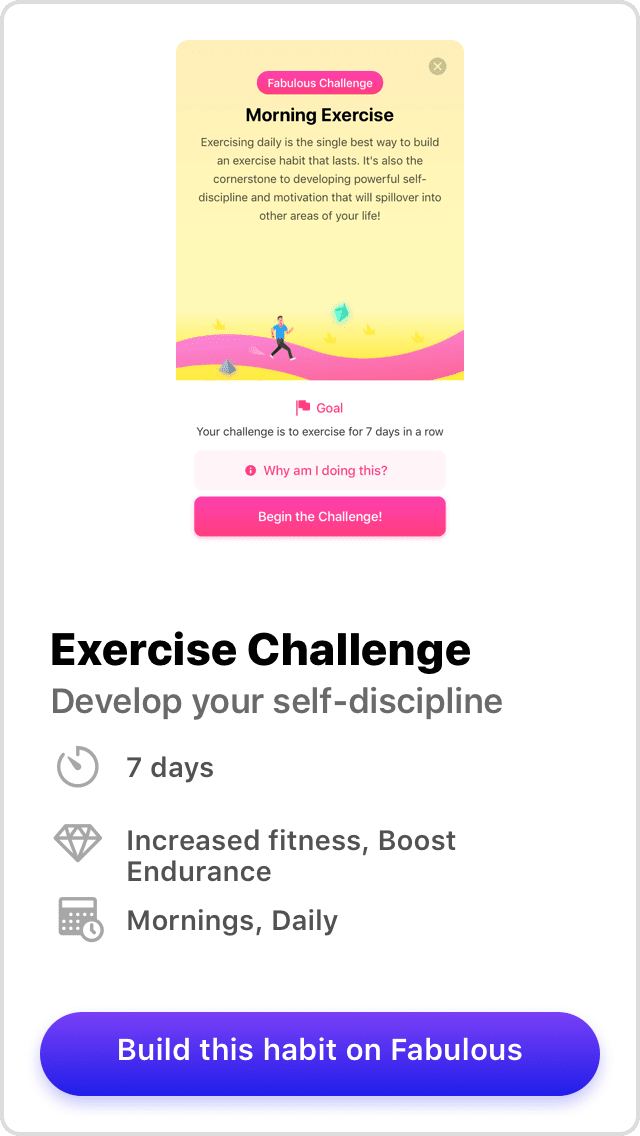Take a look at your immediate surroundings right now. What do you see? Are you in an open office, surrounded by people and distractions? Are you in your bedroom, going between staring at this screen and staring at another one? Do you ever find it hard to focus on things you want to do in places full of distractions?
You may not be consciously aware of it but your environment plays a major role in your behavior. The sounds of rowdy coworkers, the sight of our favorite food, even the time of day are all examples of environmental triggers, or cues that spur us to action. If you’ve ever tried to eat healthy but found yourself succumbing to the lure of an office birthday cake, you know this first-hand! We also know the feeling here at Fabulous; that’s why we created the Celebrating Healthy Eating journey. Give it a try!
In their book Triggers: Creating Behavior That Lasts–Becoming the Person You Want to Be, authors Marshall Goldsmith and Mark Reiter examine how these triggers affect us–for better or worse–and offer strategies to help make your triggers work for you instead of against you. If you’ve ever found yourself struggling to make a long-lasting change to your behavior (and ultimately change your life), you’ve come to the right blog post.
The Thing About Triggers
We’ve talked a lot about the habit loop on this blog. A habit loop consists of three steps: The cue (or trigger, in this case!), the response, and the reward. Normally, our focus is on the response, since that’s the part most people want to change. The problem is that all three of these steps are so tightly intertwined that it’s often impossible to change one without making changes to another!
Let’s use exercise as an example. Say you’ve recently joined a gym because you want to build an exercise habit that sticks. You bought brand new workout clothes and a water bottle you love. You have everything you need to be successful at the gym… but you still can’t seem to get yourself there each day. Why is that?
Chances are, you don’t have anything in your environment to trigger the exercise habit. Your workout clothes are likely buried in the back of your closet somewhere instead of out in plain sight to remind you of your plans. Maybe you use your water bottle both in and out of the gym, so you don’t associate filling it up with getting ready to go work out. Changing your environment–laying out your clothes and shoes ahead of time, for example–makes you more likely to experience the trigger that leads to you completing your habit.
Some triggers aren’t as subtle. If you’re doing Fabulous’s Morning Exercise Challenge, for example, your trigger might be the app’s alarm!
How to Use Triggers to Your Advantage
It’s very difficult to change. You may have heard of Isaac Newton’s first law of motion: An object in motion tends to stay in motion. This rings true even with our behavior. When you have a habit that’s familiar, comfortable, or pleasurable, steering away from that to start something new and unfamiliar can be incredibly difficult or distressing.
If you’re getting nervous, don’t worry. Change isn’t easy, but as Fabulous’s thousands of successful users know, it’s definitely possible. All it takes is awareness, willingness, and effort (and a little support from like-minded people doesn’t hurt, either). And since you’re here reading this blog, you’re already aware and willing!
Recognize Your Triggers
You can’t change the behavior surrounding your triggers if you don’t know what those triggers are! Exercising a little bit of mindfulness as you go through your day can help you identify them. Look for cues that make you want to act a certain way. Some triggers will be external, like the smell of freshly-baked bread as you walk past your favorite bakery or the sight of your living room couch after a long day. Others will be internal, like a craving for chocolate or feeling sleepy. It might also help you to write your triggers down: adding the Write in My Journal habit to your Fabulous routine can be a trigger to help remind you to do that.
Change Your Environment
Once you start recognizing your triggers, you can start structuring your environment around triggers that encourage positive behavior while eliminating triggers that lead to unwanted behavior. For example, if you want to eat healthy but find yourself binging on junk food as soon as you see it, one way to combat this behavior could be to throw away all the junk food in your pantry. It might seem wasteful, but when you compare it to the cost of your long-term health, is it really worth it to keep unhealthy foods around?
Alternatively, if you want to make sure you go to the gym every day after work, pack your gym clothes ahead of time and bring them to work with you. When you see you gym bag at the end of the day, you’ll be reminded that it’s time to work out! That’s one of many tips Fabulous suggests in its Start an Exercise Habit journey, where the app teaches you how to build an exercise habit that sticks. Check it out in the app!
Utilize Feedback
A major part of behavioral change is simply trial and error. Human behavior is a science and altering a behavior requires a scientific approach. As you experiment with different triggers in your life, be sure to keep a record of what works and what doesn’t. Habit trackers or a daily journal can help you reflect on how you’re doing now versus how you want to be. Keeping track of your habits in writing can also give you hard evidence when you need to make improvements, so you don’t find yourself stuck in a routine that isn’t working for you.
Goldsmith and Reiter recommend what they call the Six Daily Self-Questions. Once a day, ask yourself the following questions, and rate your answer on a scale of one to ten:
- Did I do my best to set clear goals today?
- Did I do my best to make progress toward my goals today?
- Did I do my best to find meaning today?
- Did I do my best to be happy today?
- Did I do my best to build positive relationships today?
- Did I do my best to be fully engaged today?
Note that each question starts with “Did I do my best?” You may not always fully succeed at achieving all your daily goals; in fact, that’d be pretty remarkable if you did! But it’s not the results that matter: it’s the effort you put into achieving those results. As long as you’re making the effort, you’re on the right track.







